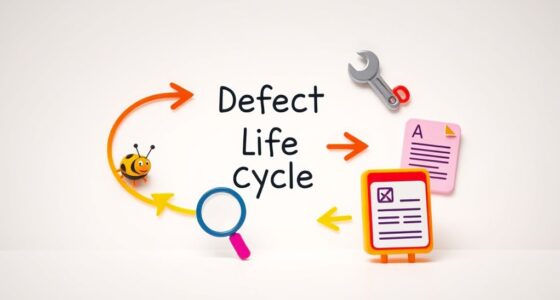Ensuring high standards of quality in our Scrum process is crucial. It demands a comprehensive and rigorous effort that necessitates the cooperation of all team members.
From defining and adhering to the Definition of Done to implementing effective Test-Driven Development practices, there are numerous strategies and techniques that we employ to maintain high quality in our work.
But how exactly do we integrate these practices into our Scrum process to ensure that the end product meets the highest quality standards?
Let's explore the key strategies and best practices that drive quality in Scrum.
Key Takeaways
- Definition of Done (DoD) is critical for ensuring quality in Scrum
- Test-driven development and frequent code reviews are essential for maintaining high code quality
- Feedback loops and collaboration are crucial for continuous improvement and early error identification
- Team accountability and continuous improvement actions contribute to delivering valuable, error-free increments
Definition of Done
What exactly constitutes the Definition of Done in Scrum and why is it crucial for maintaining product quality?
The Definition of Done (DoD) is a critical aspect of Scrum that ensures the quality of deliverables in product development.
It's a set of criteria that must be met for each product increment to be considered complete.
This includes all the essential tasks such as coding, testing, documentation, and integration.
Adhering to the DoD is the responsibility of the Development Team, and it serves as a standard for accountability within the team.
By ensuring that every increment meets the required standards and is potentially shippable, the DoD plays a vital role in maintaining product quality.
It provides a clear and agreed-upon set of guidelines that the team must follow, which ultimately leads to a more consistent and higher quality product.
In the fast-paced environment of Scrum, the Definition of Done acts as a safeguard against overlooking essential tasks and helps in delivering valuable and high-quality products to the customers.
Test-Driven Development

Test-Driven Development (TDD) emphasizes writing automated tests before coding to ensure the desired functionality, promoting code quality from the outset. This approach has several key benefits for the Scrum Team and product development:
- Quality Assurance: TDD ensures that the code meets the desired functionality, reducing the likelihood of defects and errors.
- Continuous Improvement: By focusing on testable and functional code, TDD promotes continuous improvement and a proactive approach to quality assurance within the Development Team.
- Efficient Development: TDD helps design code with quality in mind, leading to lean and efficient development by considering expected outcomes and edge cases from the beginning.
Implementing TDD within the Scrum framework can significantly enhance the quality of the product. Test cases are created before the code, providing a clear set of criteria for the Development Team to meet. This approach not only reduces errors but also fosters a culture of quality within the team. TDD aligns with the Scrum value of commitment to quality, enabling the team to deliver high-quality, reliable software.
Frequent Code Reviews
Frequent code reviews are essential for maintaining high code quality and ensuring continuous improvement.
By using a review checklist, we can systematically identify and address issues early in the development process.
This approach fosters a culture of collaboration and constructive feedback among the development team.
Review Checklist
To ensure the quality of the code, our team consistently conducts thorough and frequent code reviews using a comprehensive review checklist. This allows us to maintain high standards of quality assurance throughout the product development process.
Our review checklist includes:
- Adherence to Acceptance Criteria: We ensure that the code meets the acceptance criteria outlined for each user story in the Sprint Backlog.
- Best Practices and Standards: We verify that the code follows the defined best practices and coding standards set by the Scrum Team.
- Functional and Non-Functional Requirements: We assess whether the code fulfills both the functional and non-functional requirements specified in the product backlog.
Continuous Improvement
In our pursuit of continuous improvement, our team upholds the practice of conducting frequent code reviews to ensure the ongoing quality of our code.
Within our Scrum Team, this iterative approach to product development allows us to identify and address any deviations from the expected behavior early in the process, contributing to the overall quality of the software.
Feedback loops established through regular code reviews enable us to enhance readability, maintainability, and adherence to coding standards.
By fostering a culture of continuous improvement, we not only catch and rectify errors or defects sooner but also facilitate knowledge sharing and collaboration among developers.
This proactive approach to quality assurance strengthens our ability to deliver high-quality, reliable software products.
Automated Testing and Deployment

We've embraced automated testing and deployment to reap the benefits of efficiency and reliability.
By automating various testing types, such as unit, integration, and performance tests, we ensure code quality while saving time and reducing the risk of defects.
Moreover, deploying software across different environments using automated tools and scripts enhances consistency and reliability, allowing us to focus on delivering high-quality sprint outcomes.
Testing Automation Benefits
Automated testing and deployment significantly improve the reliability and consistency of the development process, reducing manual errors and saving time and resources.
The benefits of testing automation include:
- Faster and more frequent testing and deployment, enhancing security and overall quality
- Rapid feedback from various automated tests (unit, integration, regression, and performance tests) to reduce the risk of defects and prevent code changes from introducing regressions
- Freeing up time by automating repetitive testing tasks, allowing for more complex quality assurance efforts and aligning with Scrum principles for improved product quality
Deployment Efficiency
Enhancing deployment efficiency through automated testing and deployment is a critical aspect of ensuring quality in the Scrum development process. In the realm of product development, the Scrum Team must adhere to the guidelines set forth in the Scrum Guide and the Definition of Done (DoD) to guarantee the delivery of high-quality increments.
By integrating automated testing into the development pipeline, teams can quickly identify and address any issues, ensuring that the Product Backlog items meet the required quality standards before being released.
Moreover, automated deployment processes streamline the delivery of increments, reducing the risk of human error and enabling frequent releases. Embracing these practices not only accelerates the development cycle but also enhances the overall quality of the product, ultimately leading to greater customer satisfaction.
Feedback Loops

Feedback loops play a crucial role in ensuring continuous improvement and quality in Scrum, allowing the team to learn from experience and stakeholder engagement. In the realm of product development, the Scrum Team relies on feedback loops to maintain high quality and meet customer expectations. Here are three key aspects to consider:
- Early Error Identification: Repetitive testing during Sprints helps identify errors or defects earlier, creating a feedback loop for quality assurance. This proactive approach contributes significantly to maintaining high standards of quality throughout the development process.
- Stakeholder Engagement: In Scrum, stakeholder engagement creates feedback loops that reduce the gap between customer expectations and actual deliverables. This continuous interaction ensures that the product meets or exceeds customer needs, contributing to overall quality and satisfaction.
- Collaboration and Communication: Collaboration and feedback loops, such as user testing, demos, retrospectives, and surveys, play a vital role in maintaining quality in Sprints. Effective communication and collaboration within the Scrum Team and with stakeholders are essential for gathering and acting upon feedback, leading to continuous improvement and high-quality deliverables.
Quality Culture

Let's talk about the critical elements that contribute to a strong quality culture within a Scrum team.
Team accountability plays a vital role in ensuring that everyone is committed to upholding quality standards and taking ownership of their work.
Continuous improvement is also key, as it allows us to adapt and enhance our quality practices over time, ensuring that we're always striving to deliver the best possible product.
Team Accountability
In our Scrum team, collective accountability is foundational to ensuring the creation of valuable increments and maintaining high quality throughout our development process.
When it comes to team accountability in product development, the following key points are essential:
- Shared Responsibility: The entire Scrum Team is responsible for the quality of the increment and achieving the expected outcomes.
- Role-specific Accountability: Each role within the team, including the Product Owner, Development Team, and Scrum Master, has specific responsibilities contributing to the overall quality of the product.
- Definition of Done (DoD): Adhering to the DoD is the responsibility of the Development Team to ensure the quality of the increment meets the required standards.
Continuous Improvement
As we prioritize team accountability for maintaining high quality in our Scrum process, we actively foster a culture of continuous improvement to ensure ongoing enhancement of our product development practices. Continuous improvement is integral to our quality culture, where the Scrum Team is responsible for quality, and every member is committed to refining our processes. In the context of product development, quality means delivering valuable, error-free increments. To facilitate continuous improvement, we regularly inspect our work and adapt our Sprint Backlog to address any identified areas for enhancement. Here's an example of how we approach continuous improvement:
| Identified Area for Improvement | Action Taken |
|---|---|
| Testing processes | Implemented automated testing for faster feedback loops |
| Code review | Introduced pair programming to enhance code quality |
| Communication within the team | Conducted daily stand-up meetings for better collaboration |
Clear Definition of Done
Crafting a precise and comprehensive Definition of Done is essential for maintaining quality within the Scrum framework. The Definition of Done (DoD) serves as a shared understanding of completeness within the Scrum Team and is vital for ensuring high-quality product development.
Key points to consider are:
- Comprehensive Criteria: DoD should encompass all necessary tasks, including testing, documentation, and acceptance criteria, to deem an increment as complete.
- Adaptability: It may be revisited during retrospectives to adapt to changing requirements and uphold quality standards.
- Shared Responsibility: Adhering to DoD is a shared responsibility of the Development Team and acts as a cornerstone for building a quality culture within the Scrum framework.
Crafting and adhering to a clear Definition of Done is crucial for maintaining quality and meeting the expectations of the Product Owner and end-users.
Responsibility for Quality

Team members are collectively responsible for ensuring the quality of the product in Scrum. In the context of product development, the Scrum Team holds itself accountable for delivering a high-quality product. Each member has a role to play in upholding this responsibility, from developers and testers to product owners and Scrum Masters. Quality in Scrum isn't the sole concern of a specific team or individual; it's a shared commitment that permeates every aspect of the development process.
Assessing and ensuring quality is an ongoing endeavor within the Scrum framework. It involves continuous evaluation, adaptation, and improvement throughout the development cycle. The Scrum Team collaborates to establish clear quality standards and regularly assesses whether the product meets these criteria. This ongoing assessment ensures that any deviations from the desired quality can be promptly addressed and rectified.
Ultimately, the responsibility for quality rests with the entire Scrum Team. By fostering a culture of shared ownership and accountability, the team can consistently deliver high-quality products that meet the needs and expectations of the stakeholders.
QA Experts in Scrum

QA specialists in Scrum play a pivotal role in guiding the development process and ensuring product quality. As part of the Scrum Team, we actively contribute to defining and refining the Definition of Done (DoD), ensuring that the acceptance criteria for each product backlog item are well-defined and understood by all team members.
Our involvement in test planning and execution is crucial to monitor submissions and prevent defects early in the product development cycle. Additionally, we continuously improve testing processes and techniques to enhance overall quality awareness within the team.
Collaboration within the Scrum Team, especially between QA specialists and other team members, is essential for achieving quality solutions. We actively engage in retrospectives to identify areas for improvement and promote a culture of continuous learning and growth. Our active participation in Scrum events and ceremonies ensures that the voice of the customer is represented, contributing to the overall quality of the product.
Having QA specialists as part of the Scrum Team not only improves product quality but also brings a different perspective that enhances the team's ability to deliver high-quality products to the satisfaction of product owners and end-users.
Quality Assurance Practices

Regularly reviewing and refining quality assurance practices is essential for maintaining high standards in product development within a Scrum framework. Quality assurance practices encompass a range of activities aimed at ensuring the quality of the product throughout its development lifecycle.
In our Scrum Team, we place a strong emphasis on proactive quality assurance measures to detect and prevent defects early in the development process. This includes continuous integration, automated testing, and regular code reviews to uphold the quality of the product.
Incorporating quality assurance practices into our development process enables us to identify and address potential issues before they impact the end product. It also helps in fostering a culture of quality within the Scrum Team, where every team member takes responsibility for the overall quality of the product.
Furthermore, as privacy concerns continue to be a critical aspect of product development, we integrate privacy-focused quality assurance practices into our processes. This involves conducting privacy impact assessments, implementing privacy by design principles, and ensuring compliance with relevant data protection regulations. By doing so, we not only maintain the quality of our product but also instill trust and confidence in our customers regarding their privacy and data security.
Continuous Improvement

Incorporating continuous improvement practices into our development process enables us to further enhance the quality of the product and drive ongoing learning and adaptation within our Scrum framework. To achieve this, the Scrum Team focuses on the following key areas:
- Regular Retrospective Meetings: We hold regular retrospective meetings to reflect on our work and identify areas for improvement. This allows us to address any issues promptly and continuously enhance our processes.
- Feedback Utilization: We actively seek and utilize feedback from stakeholders and end users to drive continuous improvement in the product. This ensures that we're always aligned with the needs and expectations of our users.
- Data-Driven Decision Making: We employ metrics and data analysis to identify areas for enhancement and make informed decisions. This approach ensures that our continuous improvement efforts are based on factual insights, leading to high-quality outcomes.
Product Backlog Refinement

To ensure the readiness of upcoming sprint items, the Scrum Team continuously reviews and improves the Product Backlog through a collaborative and ongoing process known as Product Backlog Refinement.
This essential activity involves refining and preparing backlog items for implementation in future Sprints. The Scrum Team, including the Product Owner, Scrum Master, and Development Team, actively participates in adding detail, estimating, and ordering the Product Backlog items to reflect the latest information and understanding.
During refinement sessions, the team assesses the clarity and feasibility of the items, ensuring they're clear, feasible, and ready for the Development Team to work on. The Product Owner, in collaboration with stakeholders, plays a crucial role in clarifying requirements and ensuring that the Product Backlog items align with stakeholder needs and priorities.
Product Backlog Refinement is an ongoing process throughout the Sprint, maintaining the quality and readiness of the backlog. The Scrum Team continually works together to ensure that the Definition of Done (DoD) is met and that the assessment questions and answers are thoroughly reviewed and addressed during these refinement sessions.
Sprint Retrospectives

As we reflect on our past sprint activities, the Scrum Team comes together for Sprint Retrospectives to assess and improve our team's processes and teamwork. Sprint Retrospectives are crucial for ensuring the quality of our work and continuously enhancing our performance.
Here are key aspects to consider during these retrospectives:
- Quality Improvement: During Sprint Retrospectives, the Scrum Team focuses on identifying areas where the quality of work can be enhanced. We discuss any issues with meeting the Definition of Done (DoD) and strategize on improving our adherence to quality standards.
- Team Collaboration: We use this time to evaluate how effectively we've been working together as a team. This includes communication, collaboration, and addressing any interpersonal issues that may have arisen during the Sprint.
- Scrum Master Facilitation: The Scrum Master plays a vital role in ensuring that the retrospective is productive and that all team members have the opportunity to contribute their thoughts and insights. They facilitate the discussion, encouraging open and honest communication to drive meaningful improvements.
Sprint Retrospectives serve as a platform for the Scrum Team to collectively analyze their performance, identify areas for improvement, and take actionable steps to enhance the quality of their work in subsequent Sprints.
Frequently Asked Questions
How Do You Manage Quality in Scrum?
We manage quality in Scrum by fostering a culture of continuous improvement. Our team ensures that every increment meets required standards through the Definition of Done, a shared responsibility.
We engage stakeholders regularly to align with quality requirements. Automating testing and deployment reduces manual errors and increases reliability. QA specialists actively contribute to defining the DoD, participate in test planning, and continuously improve testing processes.
This approach ensures high-quality deliverables in our Scrum projects.
How Do You Ensure Quality in Agile Projects?
In agile projects, ensuring quality is like tending a garden; it requires constant attention and nurturing. We prioritize quality by conducting regular testing, collaborating closely with stakeholders, and continuously improving our processes.
Our team emphasizes early and frequent feedback to identify and address any potential issues. By adhering to agile principles and incorporating quality into every stage of the development process, we ensure that our deliverables meet the highest standards.
What Is Quality Assurance in Scrum?
Quality assurance in Scrum entails ensuring that the product meets acceptance criteria and delivers expected business value. We focus on delivering high-quality completed products and continuously improving to adapt to changing requirements.
Repetitive testing during Sprints helps us identify errors or defects early on. This approach allows us to address any issues promptly and ensures that the final product meets the desired quality standards.
Stakeholder engagement is crucial in ensuring quality in Scrum. By involving stakeholders throughout the development process, we can gather feedback and make necessary adjustments to meet their expectations. This collaborative approach helps us maintain a high standard of quality throughout the development process.
How Do You Measure the Quality of a User Story?
Measuring the quality of a user story involves assessing if it meets the Acceptance Criteria and delivers the expected business value.
We employ continuous testing and stakeholder engagement to identify and address any errors or defects early in the process.
Our Definition of Done ensures that each increment meets required standards.
This approach enables us to maintain high-quality standards and deliver valuable increments consistently, meeting the needs of our stakeholders.
Conclusion
In conclusion, ensuring quality in Scrum is like tending to a garden.
By following the Definition of Done, practicing Test-Driven Development, and nurturing feedback loops, we can cultivate a flourishing product.
Just as a gardener continuously improves their methods and tends to their plants, the Scrum team must also engage in continuous improvement and product backlog refinement to deliver a valuable and high-quality increment.









